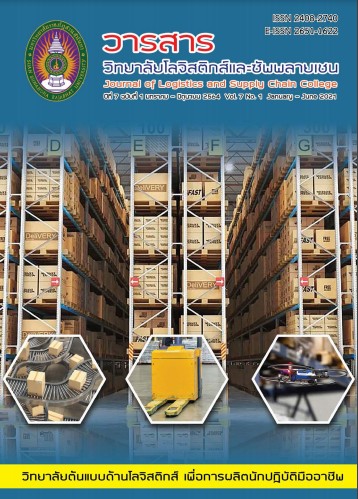Logistics Cost and Food Safety Hazards of Fresh Chili Supply Chain
Keywords:
Logistics Costs, Fresh Chili, Food Safety, Fresh Chili Supply ChainAbstract
The objective of this research aimed to 1) analyze logistics cost of fresh chili and 2) study food safety hazards in fresh chili supply chain. The survey research was applied as a research methodology. The population used in this study was fresh chili farmers, merchants and curry products processing factory in the South of Thailand that were Songkhla, Phatthalung, and Nakhon Si Thammarat. Sample size was 60 samples. The research tools were in-depth interviews and questionnaires. The data collection method was field research. The collected data was analyzed in frequency and percentage. Logistics costs were analyzed based on activity-based costing, and physical hazards were analyzed in food safety analysis. From the survey and data analysis, it was found that the cost of cultivating and harvesting fresh chili in Phatthalung was the most at 27.20 Baht per kg., followed by Songkhla at 17.51 Baht per kg., and Nakhon Si Thammarat at 16.81 Baht per kg., respectively. For local collectors, it was found that all three Provinces had similar collection cost of 0.51 Baht per kg. For wholesalers at main markets in Nakhon Si Thammarat and Songkhla, the collecting cost was 2.69 Baht per kg and 8.19 Baht per kg, respectively. In the analysis of food hazards, the use of plastic buckets or plastic bags could cause mold, and delayed transportation could result in the increasing deterioration and potential air contamination. Therefore, the farmers collaboration should promote by applying integration planning of cultivation and harvesting in order to reduce labor cost. Moreover, integrated transportation was also required to prevent product deterioration and to reduce logistics cost. In food safety aspects, the containers and packages used during packing and transporting should be replaced.
References
กฤช สิทธิวางค์กูล. (2555). การวิเคราะห์ต้นทุนโลจิสติกส์ในอุตสาหกรรมแปรรูปผักของศูนย์พัฒนาโครงการหลวงหนองหอยโดยใช้แนวทางต้นทุนฐานกิจกรรม. วิทยานิพนธ์ปริญญามหาบัณฑิต สาขาวิชาวิศวกรรมอุตสาหการ, มหาวิทยาลัยเชียงใหม่.
จิราวดี สุแดงน้อย และ เพียรศักดิ์ ภักดี. (2554). การจัดการการผลิตและการตลาดพริกสดของเกษตรกร ตำบลแหลมทอง อำเภอภักดีชุมพล จังหวัดชัยภูมิ. วารสารวิจัย มข. (บศ.). 11(4), 173-182.
ธนากร เกรอต, ภัทรเวช ธาราเวชรักษ์ และ ชูศักดิ์ พรสิงห์. (2561). การวิเคราะห์และลดต้นทุนโลจิสตกิส์สำหรับผักออร์แกนิคในภาคตะวันตกของประเทศไทย. วารสารมหาวิทยาลัยศรีนครินทรวิโรฒ (สาขาวิทยาศาสตร์และเทคโนโลยี). 10(19), 75-91.
นภาพร เชี่ยวชาญ. (2547). อันตรายที่เกี่ยวข้องกับอาหาร. ค้นเมื่อ 12 พฤษภาคม 2562, จาก: https://digital.lib.kmutt.ac.th/magazine/issue1/cover/quality.html
บุญชม ศรีสะอาด. (2545). การวิจัยเบื้องต้น. พิมพ์ครั้งที่ 22. กรุงเทพฯ: จุฬาลงกรณ์มหาวิทยาลัย.
พัชรินทร์ สุภาพันธ์ และ เบญจพรรณ เอกะสิงห์. (2560). การจัดการห่วงโซ่อุปทานด้วยตัวแบบ SCOR ของผักสดที่ผ่านการรับรองมาตรฐานการับรองการผลิตทางการเกษตรที่ดีที่เหมาะสมในจังหวัดเชียงใหม่. วารสารปาริชาติ. 30(1), 95-119.
ยิ่งยศ ทิพย์ศรีราช, คณิศร ภูนิคม และ จิรวัฒน์ ณ พัทลุง. (2561). แนวทางการลดต้นทุนโลจิสติกส์ผลไม้ตะวันออก กรณีศึกษาทุเรียนจังหวัดระยอง. รายงานสืบเนื่องการประชุมวิชาการข่ายงานวิศวกรรมอุตสาหการ ประจำปี พ.ศ. 2561, วันที่ 23-26 กรกฎาคม 2561 ณ โรงแรมสุนีย์ แกรนด์ แอนด์ คอนเวนชั่น เซ็นเตอร์ อุบลราชธานี, 1241-1247.
วันเพ็ญ แสงทองพินิจ, อัจฉรา ภู่แดง และ เบญจวรรณ โมราศี. (2555). การตรวจสอบการปนเปื้อนเชื้อจุลินทรีย์มะเขือเทศราชินีของกลุ่มวิสาหกิจชุมชนตำบลดอนตูม อำเภอบางเลน จังหวัดนครปฐม. รายงานสืบเนื่องการประชุมวิชาการ The 4th NPRU National Conference 2012, วันที่ 12-13 กรกฎาคม 2555 ณ มหาวิทยาลัยราชภัฏนครปฐม นครปฐม, 1-10.
ศิริทรัพย์ จบเจนภัย, ธนัญญา วสุศรี และ วาริช ศรีละออง. (2557). การวิเคราะห์ต้นทุนการผลิตในโซ่อุปทานกล้วยไข่ กรณีศึกษาจังหวัดจันทบุรีและจังหวัดเพชรบุรี. วารสารวิชาการเกษตร. 32(1), 16-34.
ศูนย์สารสนเทศ กรมส่งเสริมการเกษตร. (2556). ผลผลิตพริกแต่ละชนิดรายภาคปี 2559. ค้นเมื่อ 5 มีนาคม 2563, จาก: http://production.doae.go.th.
ศูนย์สารสนเทศ กรมส่งเสริมการเกษตร. (2560). พื้นที่ปลูกพริก (ไร่) และผลผลิต (ตัน) อัตราการเพิ่ม/ลด พื้นที่เพาะปลูก อัตราการเพิ่ม/ลดของผลผลิต และอัตราการเพิ่ม/ลดผลผลิตโดยเฉลี่ย ปี 2552-2559 (ไม่รวมพริกหยวกและพริกยักษ์). ค้นเมื่อ 5 มีนาคม 2563, จาก: http://production.doae.go.th.
สุดสายชล หอมทอง และ คุณากร ถกลพงศ์เลิศ. (2562). การปนเปื้อนของจุลินทรีย์ทั้งหมด และ Salmonella ของพริกขี้หนูในระหว่างการเพาะปลูกและกระบวนการสู่ตลาด. ว. วิทย์. เทคโน. หัวเฉียวเฉลิมพระเกียรติ. 5(2), 60-71.
สถิติการค้าระหว่างประเทศ กระทรวงพาณิชย์. (2561). ปริมาณนำเข้าและการส่งออกพริก มูลค่าการนำเข้าและการส่งออกพริก และผลิตภัณฑ์พริกของประเทศไทยปี 2555-2560. ค้นเมื่อ 5 มีนาคม 2563, จาก: http://production.moc.go.th
อรัญญา ชื่นจิต. (2561). ความต้องการวิธีการส่งเสริมการผลิตพริกของเกษตรกรในอำเภอระโนด จังหวัดสงขลา. วิทยานิพนธ์ปริญญามหาบัณฑิต สาขาวิชาพัฒนาการเกษตร, มหาวิทยาลัยสงขลานครินทร์.
Simchi-Levi, D., Kaminsky, P., and Simchi-Levi, E. (2008) Designing and Managing the Supply Chain: Concepts, Strategies and Case Studies. 3rd ed. Boston: McGraw-Hill Irwin.



